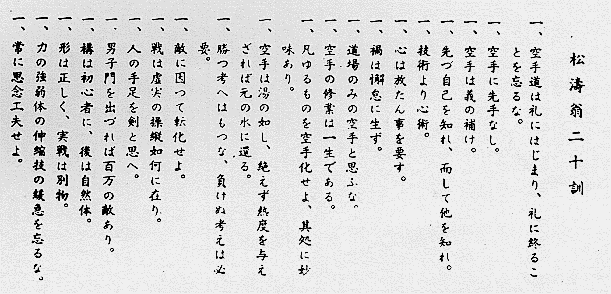Spirit first; technique second
空手は義の補け

This is the fifth in a series of posts to examine Shotokan’s niju kun, Gichin Funakoshi’s list of 20 guiding principles for karate.

The fifth principle is:
技術より心術
In Romaji:
Gijutsu yori shinjutsu.
The prevailing English translation for this seems to be:
Mentality over technique
… but I really don’t like that. It’s just kind of flat and blah.
I’ve also seen (and prefer):
Spirit first; technique second.
I think that’s the best succinct translation, provided we think of “spirit” like “attitude” (nothing supernatural). But while, I admire its brevity, it leaves room for misinterpretation, so let’s improve our understanding by looking at what’s really being said, and the man saying it.
Taken together, “技術” means “technique”, but “技” means “technique” by itself, too. Meanwhile, the “技” kanji can be read “gi”, but it can also be read “waza”, which most karateka would say is the word for “technique.” So how is “技術” different from “技” by itself? Obviously, the difference is the “術” part. 😉
Taken by itself, “術” (“jitsu”) means “way”, “art”, or “means”, but in the context of karate, “jitsu” (術) is to be differentiated from “do” (道). “Jitsu” is using the technique for practical effect, while “do” is using the technique as a path towards self betterment.
Putting all that together, Funakoshi probably meant “技術” to mean “skillful application of (karate) technique.”
Turning to “心術” (allegedly “mindset”), we find that we’ve already talked about the second kanji. “術” still means the practical application of something. This time it applies to “心”, which can mean “heart”, “mind”, “intention”, or “core.” But in this case, I think it means all of those things. Moreover, I think he means “core” in the sense of “center” or even “guts.”
This is a great example of Funakoshi getting maximum mileage out of minimal brush strokes. With only six characters, he’s telling us that our ability to use a combination of heart, mind, intention, and “guts”, is more important than skillful application of technique. But that’s still quite a bit to unpack.
On one hand, he’s saying that, given the choice between using your mind to avoid a fight, and using your skills to get through it, you should always choose the former. On the other hand, he’s saying once a fight is unavoidable, “heart and guts” (i.e. a “never give up” attitude) will serve you better than good technique.
So sacrificing brevity for clarity, we might translate this as:
Use your head to avoid the fight but, if you must fight, ferocious tenacity is more important than skill.
Having said that, I rather like “Spirit first; technique second” because the word “spirit” manages to conjure up the same mix of mind, attitude, and “guts” that “心” does in Funakoshi’s original, while also mirroring its brevity.